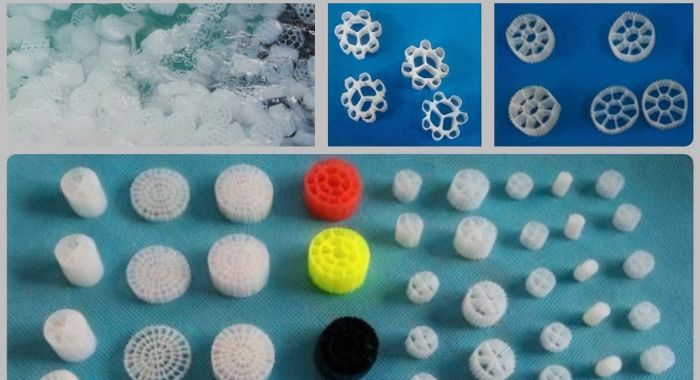MOVING BED BIOFILM REACTOR (MBBR)
1. Operating principle
The nature of MBBR is CAS/AAO/ AO process, with additional moving beds. Moving beds help to increase the surface area for biomass to tack on, hence concentration of MLSS can increase significantly. The more concentration of MLSS, the less footprint require for effluent treatment system.

2. Advantages
- Reduce footprint compared to CAS, AAO
- Moving beds can move in the movement of waste water, help better mixing, increase contact time between microorganisms and waste water, increase the efficiency of treatment
- Produce less surplus sludge compared to CAS because anaerobic and anoxic microorganisms help to treat BOD more comprehensively
- Outlet water quality can meet B or A standard, depend on design
3. Disadvantages
- Outlet water quality depends on sedimentation ability of activated sludge and size of tanks. To maintain good outlet water quality and reduce fluctuation of quality, the system require huge land/ space to build up system
- Outlet water quality maybe not stable, because sedimentation of sludge depends on many factors such as temperature, MLSS concentration, organic load and hydraulic load of inlet waste water, etc
- Footprint required is still large
- Require disinfection chemicals

If your business is interested in solution to inlet water treatment, or has a demand for ion exchange materials, please contact NGO via phone number (024) 3566 8225 or email office@8ngo.com for direct consultation.
Source: NGO
-
 Wastewater treatment
Wastewater treatment
-
 A standard domestic wastewater
A standard domestic wastewater
-
 B standard domestic wastewater
B standard domestic wastewater
-
 Pig Farm Wastewater
Pig Farm Wastewater
-
 Textile dyeing wastewater
Textile dyeing wastewater
-
 Paper industry wastewater solution
Paper industry wastewater solution
-
 Textile Dyeing Wastewater & Industrial Washing
Textile Dyeing Wastewater & Industrial Washing
-
 Slaughter wastewater treatment solution
Slaughter wastewater treatment solution
-
 Aquaculture wastewater
Aquaculture wastewater
-
 Starch wastewater
Starch wastewater
-
 Petroleum wastewater
Petroleum wastewater
-
 Beer wastewater
Beer wastewater
-
 Other industrial wastewaters
Other industrial wastewaters
-
 BioPM - Organic Industrial wastewater treatment solution
BioPM - Organic Industrial wastewater treatment solution
-
 MBR solutions
MBR solutions
-
 Conventional activated sludge (CAS)
Conventional activated sludge (CAS)
-
 Moving bed biofilm reactor (MBBR)
Moving bed biofilm reactor (MBBR)
-
 Anaerobic- Anoxic-Aerobic (AAO)
Anaerobic- Anoxic-Aerobic (AAO)
-
 Sequencing batch reactor (SBR)
Sequencing batch reactor (SBR)
-
 Physical & Chemical methods
Physical & Chemical methods
-
 Supply water treatment
Supply water treatment
-
 Cooling system water
Cooling system water
-
 Water treatment for food and Beverage production
Water treatment for food and Beverage production
-
 Ultra pure water supply solution for electronic industry
Ultra pure water supply solution for electronic industry
-
 Pure water supply for pharmaceutical manufacturers
Pure water supply for pharmaceutical manufacturers
-
 Water Supply treatment with ion exchange method
Water Supply treatment with ion exchange method
-
 Ordor Treatment
Ordor Treatment

